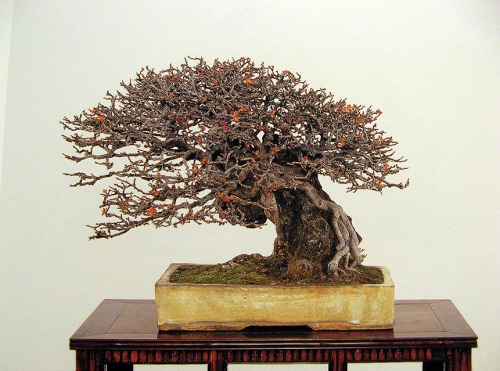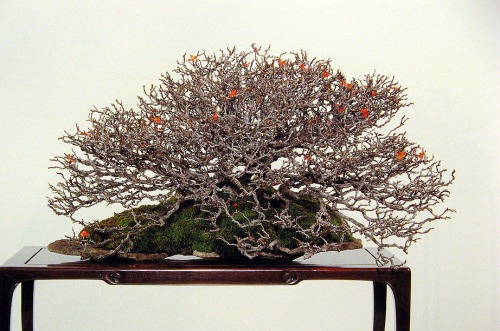Source: Bonsai Tonight
Taikan-ten setup and judging
The 2011 Grandview Bonsai Exhibit, or Taikan-ten as it is generally known, was recently held at the Miyako-messe in Kyoto, Japan. The exhibit opened on Friday, November 25th, which means a lot of bonsai professionals – and amateurs – were busy on the 24th setting everything up. As fast as folks could set up their displays, others were taking theirs apart to facilitate judging. Around midday, the aisles were full of tables with trees under consideration for awards.

Conifers awaiting judging
Large deciduous trees
The first round of judging is done by a group of bonsai professionals who narrow trees in each category down to the best three.
Professionals turning in their ballots for the suiseki category
Trees that don’t make the cut are returned to their displays. The remainder were shuffled for a second round of judging.
Large deciduous trees – final cut
Satsuki
Smaller satsuki
The tags were removed from trees that made it to the second round.
Medium shishigashira – ready for the second round
Some of the judging categories were new to me.
The bonsai-on-a-slab-or-stone category?
The bunjingi category?
Once the trees had been selected for the second round, things in the hall slowed down a bit.
Owen Reich and Peter Tea comparing tales of apprenticeship
Others used to time to check out the displays.
Bright red pyracantha berries – oh boy
The second round of judging took a long time to complete. Here the judges contemplate outstanding suiseki.
Evaluating stones
Winning entries received awards – slender, gold cards. Once all of the awards were distributed, the trees returned to their displays.
A winner!
Some displays got more attention than others. Below, a number of professionals watch the setup of a special display for the late Daizo Iwasaki. Iwasaki was one of the best-known bonsai collectors in Japan.
Many volunteer to help arrange the late Mr. Iwasaki’s bonsai and suiseki
Daizo Iwasaki
Mr. Iwasaki’s shimpaku
The vendor area was the last part of the room to come together. It included large trees and small, rough pre-bonsai and show-ready trees, tools, pots, viewing stones and other bonsai-related material.
Trees for sale
A twisty shimpaku
Shohin bonsai from Fujikawa Kouka-en
Large black pines – ¥150,000
Tiny bonsai
Powerful kifu-sized maple – ¥380,000
Stewartia - ¥300,000
Small pots
Suiseki
I’ll say more about the exhibit self later this week.
Read more!
































































